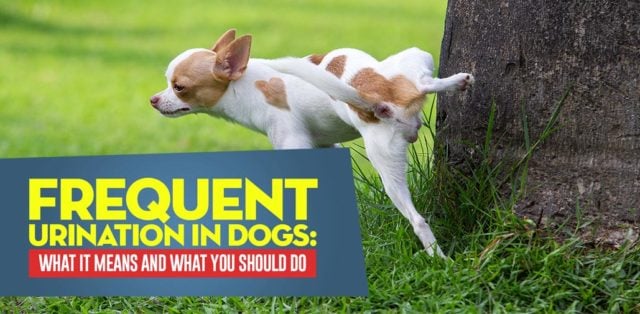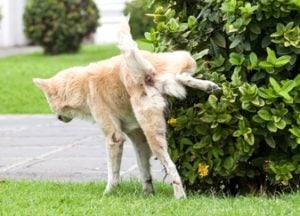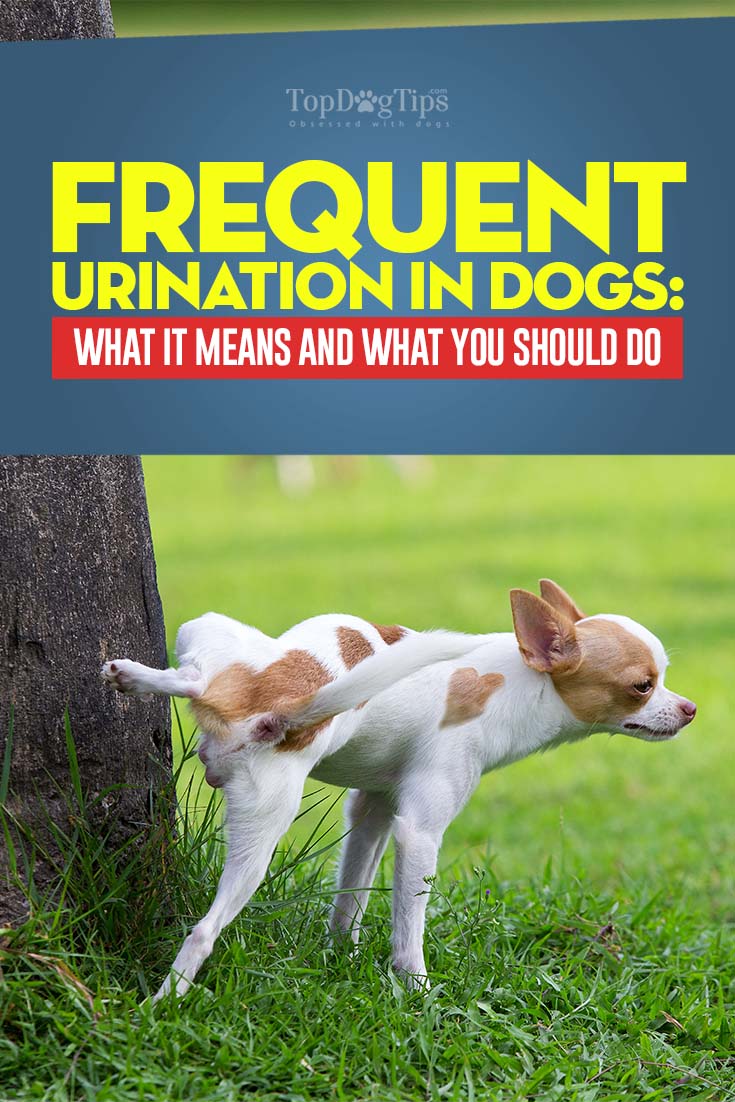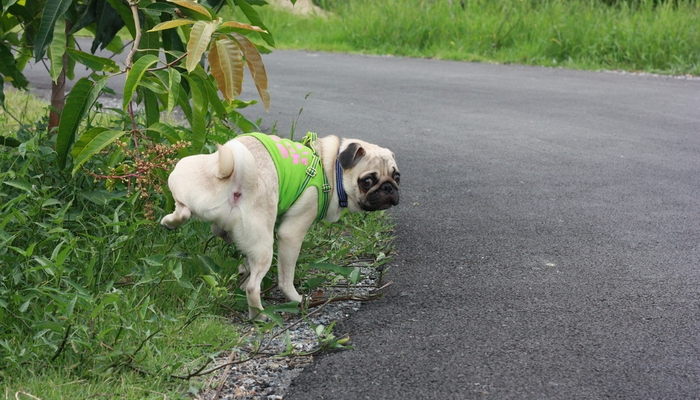
Table of Contents
You take your dog for frequent walks daily, both for fun and exercise.
As you walk along, your dog stops to smell every mailbox, fire hydrant, tree trunk, and even the neighbor dog’s droppings.
Each time you stop, your dog takes a moment to relieve itself.
Is this type of frequent urination in dogs dangerous for their health?
Over the course of your walk, your dog can urinate several times, and you wonder if it’s normal.
You shrug it off as normal territory marking behavior and get into a routine with your dog.
Generally, you like to stay up late for that last trip outside, and your dog tends to sleep soundly through the night.
But, if you start to notice your dog has been getting you up a couple of times at night and has been going much more frequently during the day, there may be a problem.
Perhaps you also notice that you have been filling up the water bowl more often.
The change has been so noticeable that you are now wondering if this is a sign that something is wrong and you should call the vet.
Drinking more water than normal, paired with frequent urination in dogs, could be a sign of a more serious health condition.
Frequent Urination In Dogs
what it means, and what you should do
What’s Typical?
You may be wondering what the typical number of times your dog should be urinating or marking throughout the day is.
The idea is to know what is normal for your dog.
Every dog is different, and many will prefer a routine and like to go out at a certain time each day.
Most dogs need to urinate every 4 to 6 hours, though many dogs will go as long as 8 to 12 hours holding their urine while their owners go out to work.
The amount of times your dog has to go will also vary based on diet, activity level, and water intake.
Dogs who are house-trained will often wait until the appropriate time to go.
Age can affect dog urination schedules as well. Puppies, older dogs, and dogs on certain medications will need to go out much more often.
When to Call the Vet
Frequent urination in dogs can be the first sign of many serious health problems, so once you have an established routine with your dog if your dog is asking to go out more often without any changes in diet or exercise, that can account for this change, then you need to see this as a serious issue to call the vet about.
You should keep track of any changes in the amount, smell, color and if your dog seems uncomfortable or is straining while urinating.
Your veterinarian will schedule an appointment and run tests on your dog’s urine to get a specific diagnosis.
You will also be asked questions about your dog’s habits and any changes you may have noticed recently.
Polydipsia and Polyuria
As you review your dog’s medical history with your veterinarian, he or she may bring up several new terms associated with your dog’s condition, such as polydipsia and polyuria.
Polydipsia is the medical term for increased levels of thirst in dogs, which generally coincides with polyuria, an abnormally high urine production level.
Your veterinarian may have requested that you bring with you a urine sample. If not, the vet may be able to get one themselves.
While your dog is at the veterinarian’s office, a full examination will be given, and your dog will be observed to determine the amount of water intake and urination.
Other standard tests include blood work for a complete blood count, a urinalysis, an antibiotic sensitivity test, and x-rays.
While frequent urination in dogs is easy to spot, finding the underlying cause can be a bit tricky.
RELATED: 25 Most Serious Dog Health Symptoms That Cannot Be Ignored
Possible Causes of Frequent Urination in Dogs
With so many tests, it is easy to become very worried about your dog.
While there are many possible causes of polyuria, most conditions are found to be easily treatable.
One of the more common causes of polyuria is UTIs or urinary tract infections.
UTIs are treated with a course of antibiotics and plenty of fluids.
Your dog’s health is important, so the tests are to rule out any other serious conditions like:
- Diabetes
- Cushing’s Disease
- Pyometra (Uterine Infection)
- Hyperthyroidism
- Liver or Kidney Failure
- Addison’s Disease
There are other conditions that could lead to polyuria, like certain medications or a high salt diet.
Also, you should be aware that there is a psychogenic polydipsia in which your dog could be a compulsive water drinker.
Any of these conditions can lead to frequent urination.
What You Should Do
Your veterinarian will give you a final diagnosis and will likely recommend a regimen of medications, diet, and exercise.
Depending on this diagnosis, you should follow the recommendations thoroughly.
 If your dog’s polyuria is due to aging, your vet may have told you that this is a natural part of the aging process. You can try working with your dog by changing its schedule and being positive if accidents occur.
If your dog’s polyuria is due to aging, your vet may have told you that this is a natural part of the aging process. You can try working with your dog by changing its schedule and being positive if accidents occur.
Incontinence can also be a problem, especially in female dogs.
This is primarily due to back injuries that occurred during the spay procedure.
Be sure if your dog is prescribed antibiotics for a UTI to finish the entire course of medications even if your dog appears better.
This is very important in order to be sure that your dog is completely better, but also to avoid creating new strains of antibiotic-resistant bacteria.
If your dog tests positive for diabetes, you will need to follow your veterinarian’s instructions closely.
Diabetes, in the form of diabetes mellitus, basically means your dog’s digestive system cannot effectively convert food into usable energy (Pena, 2017).
Your dog has polydipsia and is drinking more water in order to pass the additional food it eats to keep its blood sugars up.
While diabetes cannot be cured, you can work with your dog to manage it with diet, exercise, and medication.
Continuing to familiarize yourself with your dog’s urination habits is a good practice to get into.
Be sure to note the difference between normal urination and marking.
Normal urination is often a long and steady stream. Marking territory is often frequent and just a few drops at a time.
Taking your dog for everyday walks is one way to spend quality time together and have an opportunity to make the types of observations you need to report to your vet about frequent urination in dogs.
RECOMMENDED: 8 Expert Tips On How To Care For A Diabetic Dog
Collecting A Urine Sample
As mentioned earlier, your veterinarian may ask you to bring in a urine sample from your dog.
While you may think this is impossible, it can be done with a little trial and error.
Don’t worry too much if you can’t accomplish it, as your veterinarian has ways to get the urine sample in his office.
You will be saving time by bringing the sample with you.
Here are some ideas on how you might go about collecting your dog’s urine sample:
Female dogs – As your dog begins to squat, slide a clean aluminum pie plate beneath her to catch the urine, then transfer it to a clean container with a lid.
Male dogs – Using a large clean cup, get near your dog as he begins to raise his leg and reach around to catch the urine midstream.
Wash your hands and transfer urine to a clean container with a lid.
For both of these ideas on collecting your dog’s urine, it is advised to wear rubber gloves.
Wash your hands thoroughly if you get any urine on you.
The urine sample should be taken to the veterinarian’s office as soon as possible because urine can change with time and temperature.
Remember, if you are not able to get a urine sample when you take your dog to the office, the veterinarian’s assistant should be able to take care of your dog.
READ NEXT: How To Collect A Urine Sample From A Dog
Want to share this?
















